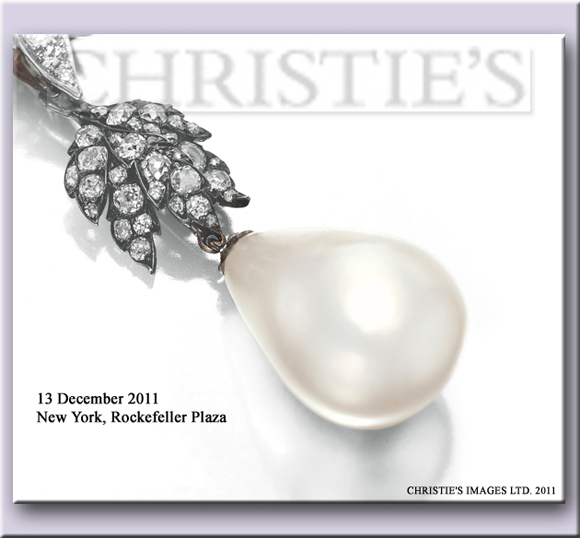Liz Taylor’s Adventure with the Most Famous Pearl in the World
January 26th, 2012 by James L. Sweaney, CGA, FGA. GGLast year, after Elizabeth Taylor’s passing, the gem world was all abuzz with the upcoming auction of her famous jewelry collection. Noted auction house, Christie’s, New York would hold an evening sale, December 13, 2011.
When all the bids were in, the sale fetched record amounts for most of her pieces, including almost $12,000,000 for her pearl necklace. A lovely diamond, ruby, and pearl confection by Cartier, the piece features the most famous pearl in the world, a wonderful inch long pear shaped natural pearl known as La Peregrina. La Peregrina was fished off the coast of Panama around 1570, and has been owned by kings and assorted royals.
Natural pearls are and have always been a rarity– in these days of plentiful cultured pearls, we tend to forget how precious and valuable they have been historically. A famous story tells how in 1913, Pierre Cartier traded a single strand of 55 natural pearls valued at 1.2 million dollars for a mansion on Fifth Avenue belonging to banker Morton Plant– that property is now Cartier’s U.S. flagship store at Fifth Avenue and 52nd Street!
I had a secret story to tell about La Peregrina, had thought about it all year, and when the necklace sold for six times the auction house estimate, I decided to share it with Gary Roskin. An old friend and colleague from my days working as a gemologist, teacher, and lab supervisor at GIA, Gary is now a well known journalist specializing in the gem industry, currently publishing the Roskin Gem News Report.
My story is this– In 1981 I left GIA to work with John Latendresse, a noted pearl dealer who was beginning to culture freshwater pearls in the United States. To me, this was an exciting chance to be involved at the ground floor with a truly unique and ground breaking business, so my wife Kaye and I packed our bags and moved with 2 year old daughter Jenny to Tennessee!
John was a real character, leaving the family home in South Dakota at an early age to find his fortune, serving as a marine in WWII — enlisting at age 15! — and working as a casino cashier, boxer, and commercial fisherman, among other things. An avid outdoorsman, he became involved with natural pearls as a byproduct of his main business, Tennessee Shell Company. The shell company supplied many tons of freshwater pearly mussel shells to the Japanese cultured pearl industry– this thick mother-of-pearl shell is the preferred raw material for making the beads used to nucleate cultured saltwater pearls.
I think it was about the time in 1984 that noted photographer Fred Ward visited John’s pearl farm while working on an article about pearls for National Geographic. John talked with me about repairing Liz Taylor’s pearl– he’d met Elizabeth after her puppy dog chewed on La Peregrina– and matter-of-factly told me he’d “doctored” the pearl, removing tooth marks by “peeling” the pearl
Peeling is a time honored technique developed over the centuries, harkening back to the days when pearls were more valuable than emeralds and rubies. Layers of the pearl are gently and carefully removed, after which the pearl surface is smoothed. The person who does the repair is known as a pearl doctor.
I discussed the story with Gary and Gina Latendresse, John’s daughter who had heard the story from John and has carried on his pearl business, the American Pearl Company, and we decided to work together to tell the story. You can read the full story at Gary’s website, The Roskin Gem News Report.
If you’d like to learn more about pearls or see some fine examples, stop by the shop– today’s cultured pearls are very beautiful, of high quality and won’t cost millions.
Tags: Cartier, Christie's, cultured pearls, Elizabeth Taylor, John Latendresse, La Peregrina, natural pearl, pearl doctor, pearl peeling, pearly mussel, Roskin Gem News










